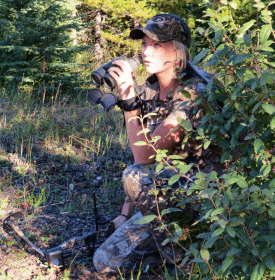- Home
- About
- Blog
- For Parents
-
Corners
- Allison’s Corner
- Amber’s Category
- Andrea’s Corner
- Ashley’s Corner
- Brandi Jo’s Corner
- Brittany’s Corner
- Brooke’s Corner
- Catrina’s Corner
- Conservation
- Desiree’s Corner
- Emily’s Corner
- Erica’s Corner
- Erin’s Corner
- Heather’s Corner
- Ivory’s Corner
- Jeana’s Corner
- Katie’s Corner
- Kelly’s Corner
- Kelsey’s Corner
- Kendra’s Corner
- Liberty’s Corner
- Lisa’s Corner
- Meagan’s Corner
- Melissa’s Corner
- Mimi’s Corner
- Morgan’s Corner
- Nicole’s Corner
- Sarah’s Corner
- Savannah’s Corner
- Shannon’s Blog
- Sharon’s Corner
- Sherri’s Corner
- Tara’s Corner
- Contact
- Guest Post

Emphasizing Optics
The raspy bugle ripped through the crisp air. Leaning into the eye piece of my spotting scope, a large silhouette contrasted against the frosty slope. Lifting my head, my eyes revealed only darkness. Thankful for my quality optics (that collect more light than my naked eye), I stared back into my scope to judge the screaming bull. With another minute and a touch more light, I counted 6 long points. This gave me the advantage I needed to immediately start the hike after the bull.
Having optics well suited for your style of hunting can greatly increase your success. From the wide open prairies, to rocky mountain ridges, and everything in between, they play a large role in my hunting strategy. Spotting game, determining weather they are legal, and critiquing the terrain around them are just some of the requirements of my optics. I currently pair up 10×42 binoculars with a 20-60×80 spotting scope. The binoculars are a great balance of size, magnification, and light collecting ability, while the scope allows me to draw in every detail of game that I’m observing.
Having quality optics is only half the battle. Knowing how and when to use them is the key. A common mistake I see is a hunter with a beautiful set of binoculars hanging from their neck, but never using them. Putting faith in the view of your naked eye leads to a lot of missed opportunities. As an example, throughly scanning over a log block with my binoculars, after an initial glance, has revealed tines of a bedded bull. I try to make it a habit to constantly take full advantage of my binoculars.
When it comes to my spotting scope, it’s always along for the hunt. Paired with a quality tripod, I relay on it for determining whether the bedded goat is a billy or nanny, how mature the mule buck is, or if the grazing ram is legal. Seeing these small details at long range has saved me miles of wear on my boots. Let your scope do the walking for you.
Not every hunter will require the same optics. If your hunting area consists of tree-standing for whitetails and calling in turkeys, a spotting scope may not be necessary. On the other hand, glassing the scrub-covered hills of coues deer country may require large, high powered binoculars mounted on a tripod. Take a good look at your hunting area and style, and determine if your optics are holding you back, or if you have the right tools for the job. Whatever your needs are, do not dismiss the importance of quality glass. Rather than looking at them as a purchase now, think of them as an investment in hunts for years to come.
Keep the wild in your heart

All excellent points, Erica. A great post! 😉